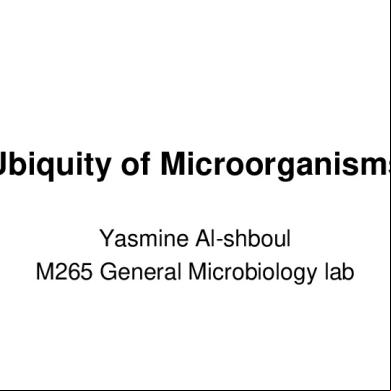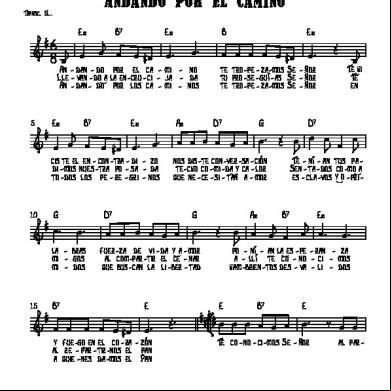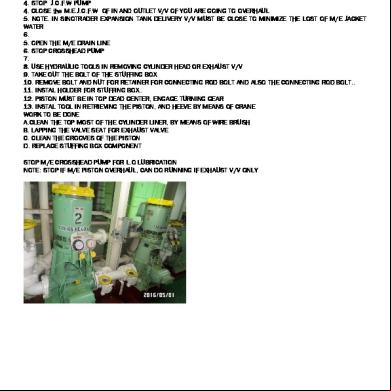Destruction Of Microorganisms 4b242
This document was ed by and they confirmed that they have the permission to share it. If you are author or own the copyright of this book, please report to us by using this report form. Report 3b7i
Overview 3e4r5l
& View Destruction Of Microorganisms as PDF for free.
More details w3441
- Words: 877
- Pages: 3
DESTRUCTION OF MICROORGANISMS – METHODS OF CONTROL STERILISATION – this means the complete destruction of all organisms present. One way in which milk is sterilized is by pasteurization. METHODS OF STERILIZATION 1) PASTEURISATION – this is the process used to preserve milk by heat treatment. Milk is heated to 63 degrees Celsius for 30 minutes and then it is cooled. It can also be heated to 77 degrees Celsius and very quickly cooled. This treatment will destroy most bacteria including the pathogen causing tuberculosis (TB). Boiling milk will also destroy the bacteria abut it spoils the taste. Pasteurization kills the lactic acid bacteria which break down lactose to form lactic acid which turns milk sour. 2) ULTRA HIGH TEMPERATURES (UHT) – Pasteurization may not deactivate certain heat-resistant bacteria spores. An even more effective method is UHT, ultra high temperature treatment. This may be used for milk and a whole range of foods such as yogurt, baby foods, stews and so on. The food is heated to more than 135 degrees celcius before packaging. UHT is more expensive to produce because of complex machinery needed to maintain an environment free from microorganisms. UHT products however can be stored for much longer periods of time. 3) AUTOCLAVING – an autoclave is used for sterilization by heat. Its structure is similar to to a dryer, but inside are wire trays to hold the tubes, plates etc. Boiling under pressure or using steam is a most effective way to kill bacteria on instruments used in surgery. Increasing the pressure ensures that higher temperatures are maintained for the complete destruction of bacteria, including the destruction of spores. In the kitchen, a pressure cooker can be used to ensure that food is free from all microorganisms and safe to eat. This maintains aseptic conditions, however the high temperatures necessary would destroy the living tissue. 4) BOILING - Sterlisation can be achieved by boiling in water at 100 degrees celsius. Very few organisms can survive temperatures of 100 degrees celsius and this method is commonly used at home to purify water. 5) DISINFECTION - This is where chemicals are used for disinfection. They include antiseptics which are important for stopping the reproduction of microorganisms. The use of chemical agents: a) CHLORINE -This is an effective way of controlling the presence of bacteria in the household and can be used for cleaning floors, bathrooms, or any other dirty area which may contain microorganisms. A drop or two can also be placed in drinking waterto destroy microorganisms. b) DISINFECTANTS - These can be used for floors and other surfaces which are non-living.
c) ANTISEPTIC - This is a chemical which can destroy or stop the reporduction of bacteria and is used on living tissues. ANTIBIOTICS - An antibiotic is a chemical produced by living organisms which will destroy bacteria (e.g. bacitracin polymyxin) Antifungal agents are chemicals which are used in the treatment of infections. (e.g. - Athlete's Foot and male fungus) VECTORS A vector can be defined as an organism that transmits a pathogen to a host without itself having the disease. Common vectors in the caribbean and their associated diseases are as follows:
MOSQUITOS - These infected mosquitos transmit diseases such as malaria and dengue to humans by sucking blood from a host. Both are fatal if proper healthcare is not available. HOUSE FLIES - These transmit as much as 30 different diseases to humans. These include cholera, typhoid dysentery etc. BATS - Bats are responsible for transmission of the rabies virus to humans either by accidental biting and droplets through the air. RATS - Rat faeces and urine may contain a bacterium which causes deptospirosis. Sometimes dogs, mice and fleas that bite them can act as vectors.
It is therefore important to control these vectors an order to
EFFECTS OF DISEASE IN HUMAN HEALTH
Nuisance Spread and communable fatal diseases Leptose sprirosis Dengue fever Rabies Gastroenteritis Important to control vectors to stop widespread disease in the populations Removal of breeding places and detruction of eggs and larvae, maintainance of environmental sanitation Proper storage and disposal of refuse.
IMMUNITY – The body’s immune system comes into action once pathogens gain entry into the body. White blood cells are activated by the invading pathogens. Bacteria and viruses have antigens on their surfaces. DEFINITIONS IMMUNITY – This is the resistance to a disease where a person is protected from or resistant to a specific microorganism. IMMUNIZATION – This is where a person is vaccinated prior to developing a disease so that if they do get a disease, they will be able to fight it. ANTIGEN – This is a large molecule, usually a protein. These antingens cause the lymphocytes to make and release the antibodies. ANTIBODIES – These are large protein molecules which destroy the pathopgens, hence the antigen on the surface of a pathogen stimulates lymphocytes to make antibodies, which destroy the pathogen. ANTITOXIN – Toxins also behave as antigens and the antibodies may as a result also be called Antitoxins. VACCINES – These are weak cultures (bacteria) which cause a very mild form of the disease. VACCINATION – This is the process by which vaccines are istered or given to a patient.
c) ANTISEPTIC - This is a chemical which can destroy or stop the reporduction of bacteria and is used on living tissues. ANTIBIOTICS - An antibiotic is a chemical produced by living organisms which will destroy bacteria (e.g. bacitracin polymyxin) Antifungal agents are chemicals which are used in the treatment of infections. (e.g. - Athlete's Foot and male fungus) VECTORS A vector can be defined as an organism that transmits a pathogen to a host without itself having the disease. Common vectors in the caribbean and their associated diseases are as follows:
MOSQUITOS - These infected mosquitos transmit diseases such as malaria and dengue to humans by sucking blood from a host. Both are fatal if proper healthcare is not available. HOUSE FLIES - These transmit as much as 30 different diseases to humans. These include cholera, typhoid dysentery etc. BATS - Bats are responsible for transmission of the rabies virus to humans either by accidental biting and droplets through the air. RATS - Rat faeces and urine may contain a bacterium which causes deptospirosis. Sometimes dogs, mice and fleas that bite them can act as vectors.
It is therefore important to control these vectors an order to
EFFECTS OF DISEASE IN HUMAN HEALTH
Nuisance Spread and communable fatal diseases Leptose sprirosis Dengue fever Rabies Gastroenteritis Important to control vectors to stop widespread disease in the populations Removal of breeding places and detruction of eggs and larvae, maintainance of environmental sanitation Proper storage and disposal of refuse.
IMMUNITY – The body’s immune system comes into action once pathogens gain entry into the body. White blood cells are activated by the invading pathogens. Bacteria and viruses have antigens on their surfaces. DEFINITIONS IMMUNITY – This is the resistance to a disease where a person is protected from or resistant to a specific microorganism. IMMUNIZATION – This is where a person is vaccinated prior to developing a disease so that if they do get a disease, they will be able to fight it. ANTIGEN – This is a large molecule, usually a protein. These antingens cause the lymphocytes to make and release the antibodies. ANTIBODIES – These are large protein molecules which destroy the pathopgens, hence the antigen on the surface of a pathogen stimulates lymphocytes to make antibodies, which destroy the pathogen. ANTITOXIN – Toxins also behave as antigens and the antibodies may as a result also be called Antitoxins. VACCINES – These are weak cultures (bacteria) which cause a very mild form of the disease. VACCINATION – This is the process by which vaccines are istered or given to a patient.











